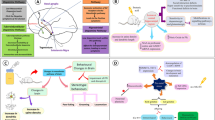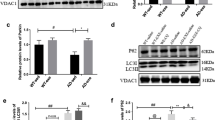Abstract
Huntington’s disease (HD) is an autosomal dominant neurodegenerative disorder characterized by choreic involuntary movements, decline in cognitive functions, behavioral disturbances, and progressive neuronal death affecting primarily the striatum. The fatal nature of HD makes it important to search for new effective methods of its treatment, which requires the development of experimental models of the disease. These models can be created using 3-nitropropionic acid (3-NPA), which is a neurotoxin causing typical changes in motor skills and memory impairment in animals due to induction of oxidative stress, impaired glutathione defense, and destruction of striatal cells. We modeled HD in rats by chronic daily intraperitoneal administration of 3-NPA for 17 days. Systemic administration of a low dose of 3-NPA (10 mg/kg) induced hyperactivity of animals in the open field test (including movement redundancy as a hyperkinesia analogue) and had no effect on the behavior of the animals in the X-maze test. On the contrary, rats administered with a toxic dose of 3-NPA (20 mg/kg) exhibited a significant decrease in their motor activity and a cognitive decline in behavioral tests. A histopathological analysis revealed damage and loss of neurons and a decrease in expression of dopaminergic markers (tyrosine hydroxylase and plasma membrane dopamine transporter) in the striatum. The gliotoxic effect of 3-NPA was also found in the striatum, which was confirmed by immunohistochemical staining for astrocytic proteins: GFAP, glutamine synthetase, and aquaporin-4. This HD model may be helpful for testing new experimental therapies at different stages of HD-like neurodegeneration, including therapies based on cell neurotransplantation.
Similar content being viewed by others
References
Illarioshkin, S.N., Age-related memory and attention disorders: mechanisms of development and possibilities of neurotransmission therapy, Nevrol. Zh., 2007, no. 2, p. 34.
Illarioshkin, S.N., Ivanova-Smolenskaya, I.A., and Markova, E.D., A new mechanism of mutation in man: expansion of trinucleotide repeats (review), Genetika, 1995, vol. 31, p. 1478.
Aketa, S., Nakase, H., Kamada, Y., et al., Chemical preconditioning with 3-nitropropionic acid in gerbil hippocampal slices: therapeutic window and the participation of adenosine receptor, Exp. Neurol., 2000, vol. 166, no. 2, p. 385.
Alexi, T., Hughes, P.E., Faull, R.L., and Williams, C.E., 3-Nitropropionic acid’s lethal triplet: cooperative pathways of neurodegeneration, Neuroreport, 1998, vol. 9, no. 11, p. R57.
Alston, T.A., Mela, L., and Bright, H.J., 3-Nitropropionate, the toxic substance of Indigofera, is a suicide inactivator of succinate dehydrogenase, Proc. Natl. Acad. Sci. U. S. A., 1977, vol. 74, no. 9, p. 3767.
Beal, M.F., Does impairment of energy metabolism result in excitotoxic neuronal death in neurodegenerative illnesses?, Ann. Neurol., 1992, vol. 31, no. 2, p. 119.
Beal, M.F., Brouillet, E., Jenkins, B.G., et al., Neurochemical and histologic characterization of striatal excitotoxic lesions produced by the mitochondrial toxin 3-nitropropionic acid, J. Neurosci., 1993, vol. 13, no. 10, p. 4181.
Becker, S. and Lim, J., A computational model of prefrontal control in free recall: strategic memory use in the California Verbal Learning Task, J. Cognit. Neurosci., 2003, vol. 15, no. 6, p. 821.
Blesa, J. and Przedborski, S., Parkinson’s disease: animal models and dopaminergic cell vulnerability, Front. Neuroanat., 2014, vol. 8, p. 155.
Borlongan, C.V., Koutouzis, T.K., Freeman, T.B., et al., Hyperactivity and hypoactivity in a rat model of Huntington’s disease: the systemic 3-nitropropionic acid model, Brain Res. Protoc., 1997, vol. 1, p. 253.
Brouillet, E., Conde, F., Beal, M., and Hantraye, P., Replicating Huntington’s desease phenotype in experimental animals, Prog. Neurobiol., 1999, vol. 59, no. 5, p. 427.
Brouillet, E., Jacquard, C., Bizat, N., and Blum, D., 3-Nitropropionic acid: a mitochondrial toxin to uncover physiopathological mechanisms underlying striatal degeneration in Huntington’s disease, J. Neurochem., 2005, vol. 95, no. 6, p. 1521.
Brouillet, E., Jenkins, B., Hyman, B., et al., Agedependent vulnerability of the striatum to the mitochondrial toxin 3-nitropropionic acid, J. Neurochem., 1993, vol. 60, p. 356.
Choo, Y.S., Johnson, G.V., MacDonald, M., et al. Mutant huntingtin directly increases susceptibility of mitochondria to the calcium-induced permeability transition and cytochrome c release, Hum. Mol. Genet., 2004, vol. 13, p. 1407.
Fukuda, A.M. and Badaut, J., Aquaporin 4: a player in cerebral edema and neuroinflammation, J. Neuroinflammation, 2012, vol. 9, p. 279.
Herrera-Mundo, N. and Sitges, M., Mechanisms underlying striatal vulnerability to 3-nitropropionic acid, J. Neurochem., 2010, vol. 114, no. 2, p. 597.
Kendall, A., Hantraye, P., and Palfi, S., Striatal tissue transplantation in non-human primates, Prog. Brain Res., 2000, vol. 127, p. 381.
Kozina, E.A., Khakimova, G.R., Khaindrava, V.G., et al., Tyrosine hydroxylase expression and activity in nigrostriatal dopaminergic neurons of MPTP-treated mice at the presymptomatic and symptomatic stages of parkinsonism, J. Neurol. Sci., 2014, vol. 340, nos. 1–2, p. 198.
Kumar, P. and Kumar, A., Effect of lycopene and epigallocatechin-3-gallate against 3-nitropropionic acid induced cognitive dysfunction and glutathione depletion in rat: A novel nitric oxide mechanism, Food Chem. Toxicol., 2009, vol. 47, no. 10, p. 2522.
Kumar, P. and Kumar, A., Protective effect of hesperidin and naringin against 3-nitropropionic acid induced Huntington’s-like symptoms in rats: Possible role of nitric oxide, Behav. Brain Res., 2010, vol. 206, no. 1, p. 38.
Kumar, P., Padi, S.S., Naidu, P.S., and Kumar, A., Cyclooxygenase inhibition attenuates 3-nitropropionic acid-induced neurotoxicity in rats: possible antioxidant mechanisms, Fundam. Clin. Pharmacol., 2007, vol. 21, no. 3, p. 297.
Lee, W.T., Yin, H.S., and Shen, Y.Z., The mechanisms of neuronal death produced by mitochondrial toxin 3-nitropropionic acid: the roles of N-methyl-D-aspartate glutamate receptors and mitochondrial calcium overload, Neuroscience, 2002, vol. 112, p. 707.
Mehrotra, A. and Sandhir, R., Mitochondrial cofactors in experimental Huntington’s disease: behavioral, biochemical and histological evaluation, Behav. Brain Res., 2014, vol. 261, p. 345.
Nishino, H., Hida, H., Kumazaki, M., et al., The striatum is the most vulnerable region in the brain to mitochondrial energy compromise: a hypothesis to explain its specific vulnerability, J. Neurotrauma, 2000, vol. 17, no. 3, p. 251.
Nishino, H., Kumazaki, M., Fukuda, A., et al., Acute 3-nitropropionic acid intoxication induces striatal astrocytic cell death and dysfunction of the blood-brain barrier: involvement of dopamine toxicity, Neurosci. Res., 1997, vol. 27, no. 4, p. 343.
Ouary, S., Bizat, N., Altairac, S., and Menetrat, H., Major strain differences in response to chronic systemic administration of the mitochondrial toxin 3-nitropropionic acid in rats: implications for neuroprotection studies, Neuroscience, 2000, vol. 97, no. 3, p. 521.
Pandey, M., Borah, A., Varghese, M., et al., Striatal dopamine level contributes to hydroxyl radical generation and subsequent neurodegeneration in the striatum in 3-nitropropionic acid-induced Huntington’s disease in rats, Neurochem. Int., 2009, vol. 55, p. 431.
Patocka, J., Bielavský, J., Cabal, J., and Fusek, J., 3-Nitropropionic acid and similar nitro-toxins, Acta Med. (Hradec Kralove), 2000, vol. 43, no. 1, p. 9.
Ramaswany, S., McBride, J., and Kordower, J., Animal models of Huntington’s desease, ILAR J., 2007, vol. 48, no. 4, p. 356.
Sandhir, R. and Mehrotra, A., Quercetin supplementation is effective in improving mitochondrial dysfunctions induced by 3-nitropropionic acid: implications in Huntington’s disease, Biochim. Biophys. Acta, 2013, vol. 1832, no. 3, p. 421.
Sandhir, R., Sood, A., Mehrotra, A., and Kamboj, S., N-Acetylcysteine reverses mitochondrial dysfunctions and behavioral abnormalities in 3-nitropropionic acidinduced Huntington’s disease, Neurodegener. Dis., 2012, vol. 9, no. 3, p. 145.
Stelmashook, E.V., Isaev, N.K., Lozier, E.R., et al., Role of glutamine in neuronal survival and death during brain ischemia and hypoglycemia, Int. J. Neurosci., 2011, vol. 121, p. 415.
A novel gene containing a trinucleotide repeat that is expanded and unstable on Huntington’s disease chromosomes. The Huntington’s Disease Collaborative Research Group, Cell, 1993, vol. 72, no. 6, p. 971.
Tunez, I., Tasset, I., Perez-De, La., Cruz, V., and Santamaria, A., 3-Nitropropionic acid as a tool to study the mechanisms involved in Huntington’s disease: past, present and future, Molecules, 2010, vol. 15, p. 878.
Van Raamsdonk, J.M., et al., Selective degeneration and nuclear localization of mutant huntingtin in the YAC128 mouse model of Huntington disease, Hum. Mol. Genet., 2005, vol. 14, no. 24, p. 3823.
Villalba, R.M. and Smith, Y., Differential structural plasticity of corticostriatal and thalamostriatal axo-spinous synapses in MPTP-treated Parkinsonian monkeys, J. Comp. Neurol., 2011, vol. 519, no. 5, p. 989.
Wüllner, U., Young, A.B., Penney, J.B., and Beal, M.F., 3-Nitropropionic acid toxicity in the striatum, J. Neurochem., 1994, vol. 63, no. 5, p. 1772.
Author information
Authors and Affiliations
Corresponding author
Additional information
Original Russian Text © A.V. Stavrovskaya, D.N. Voronkov, N.G. Yamshchikova, A.S. Ol’shanskiy, R.M. Khudoerkov, S.N. Illarioshkin, 2015, published in Annaly Klinicheskoi i Eksperimental’noi Nevrologii, 2015, Vol. 9, No. 3, pp. 49–55.
Rights and permissions
About this article
Cite this article
Stavrovskaya, A.V., Voronkov, D.N., Yamshchikova, N.G. et al. Experience of experimental modelling of Huntington’s disease. Hum Physiol 42, 898–904 (2016). https://doi.org/10.1134/S0362119716080120
Published:
Issue Date:
DOI: https://doi.org/10.1134/S0362119716080120




